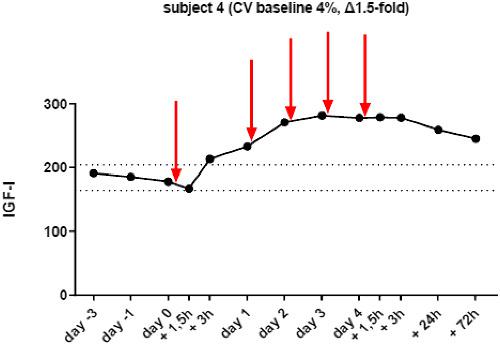当前位置:
X-MOL 学术
›
Drug Test. Anal.
›
论文详情
Our official English website, www.x-mol.net, welcomes your
feedback! (Note: you will need to create a separate account there.)
The intra‐individual stability of GH biomarkers IGF‐I and P‐III‐NP in relation to GHRH administration, menstrual cycle, and hematological parameters
Drug Testing and Analysis ( IF 2.6 ) Pub Date : 2020-10-30 , DOI: 10.1002/dta.2953 Magnus Ericsson 1, 2 , Hasanuzzaman Bhuiyan 3 , Basam Yousif 3 , Mikael Lehtihet 4 , Lena Ekström 1, 3
Drug Testing and Analysis ( IF 2.6 ) Pub Date : 2020-10-30 , DOI: 10.1002/dta.2953 Magnus Ericsson 1, 2 , Hasanuzzaman Bhuiyan 3 , Basam Yousif 3 , Mikael Lehtihet 4 , Lena Ekström 1, 3
Affiliation

|
The intra‐individual stability of growth hormone (GH) biomarkers IGF‐I, P‐III‐NP, calculated GH‐2000 score in relation to growth hormone‐releasing hormone (GHRH) (Somatorelin) administration, menstrual cycle, and hematological parameters were investigated in four men and eight women, respectively. Moreover, the hematological parameters hemoglobin (Hb) and percentage of reticulocyte (RET%) were statistically analyzed in relation to the GH biomarker parameters for the GHRH administration study and the menstrual cycle study. Longitudinal monitoring of IGF‐I and/or GH‐2000 score proved to be a viable approach to detect the GHRH intake in men, as all four participants show values above individually calculated thresholds (calculated as mean ± 3SD from three baseline samples). The intra‐individual variation for IGF‐I, P‐III‐NP, and calculated GH‐2000 score in women, over two consecutive menstrual cycles, was investigated and established to be higher (coefficients variations [CVs] between 12% and 186%) than in men (CVs between 3% and 12%). The GHRH administration did not influence the hematological parameters. A strong positive correlation between Hb and IGF‐I (Rs = 0.73, p < 0.0001) and a borderline weak correlation between RET% and IGF‐I (Rs = 0.28, p = 0.054) were noticed in the women. No correlation for the P‐III‐NP and the hematological parameters was seen for the females in the menstrual cycle study. The results fortify previous studies that longitudinal monitoring of IGF‐I and/or GH‐2000 score may be a promising method to detect doping with GH and GH stimulating agents in men, whereas the large intra‐individual variation noted in women indicates that longitudinal monitoring of these biomarker may be harder to evaluate in women.
中文翻译:

GH 生物标志物 IGF-I 和 P-III-NP 与 GHRH 给药、月经周期和血液学参数相关的个体内稳定性
生长激素 (GH) 生物标志物 IGF-I、P-III-NP 的个体内稳定性,计算出与生长激素释放激素 (GHRH) (生长激素) 给药、月经周期和血液学参数相关的 GH-2000 评分分别对四名男性和八名女性进行了调查。此外,针对GHRH给药研究和月经周期研究,对与GH生物标志物参数相关的血液学参数血红蛋白(Hb)和网织红细胞百分比(RET%)进行统计分析。纵向监测 IGF-I 和/或 GH-2000 评分被证明是检测男性 GHRH 摄入量的可行方法,因为所有四名参与者的值都高于单独计算的阈值(计算为三个基线样本的平均值 ± 3SD)。IGF-I、P-III-NP 的个体内变异,并在连续两个月经周期中对女性计算出的 GH-2000 得分进行了调查并确定其比男性(CV 在 3% 和 12% 之间)更高(系数变化 [CV] 在 12% 和 186% 之间)。GHRH 给药不影响血液学参数。Hb 和 IGF-I 之间呈强正相关(R s = 0.73, p < 0.0001) 并且在女性中观察到RET% 和 IGF-I 之间的临界弱相关性 ( R s = 0.28, p = 0.054)。在月经周期研究中,女性的 P-III-NP 和血液学参数没有相关性。结果巩固了先前的研究,即纵向监测 IGF-I 和/或 GH-2000 评分可能是检测男性使用 GH 和 GH 刺激剂的有前途的方法,而在女性中观察到的巨大个体内差异表明纵向监测这些生物标志物的 可能在女性中更难评估。
更新日期:2020-12-15
中文翻译:

GH 生物标志物 IGF-I 和 P-III-NP 与 GHRH 给药、月经周期和血液学参数相关的个体内稳定性
生长激素 (GH) 生物标志物 IGF-I、P-III-NP 的个体内稳定性,计算出与生长激素释放激素 (GHRH) (生长激素) 给药、月经周期和血液学参数相关的 GH-2000 评分分别对四名男性和八名女性进行了调查。此外,针对GHRH给药研究和月经周期研究,对与GH生物标志物参数相关的血液学参数血红蛋白(Hb)和网织红细胞百分比(RET%)进行统计分析。纵向监测 IGF-I 和/或 GH-2000 评分被证明是检测男性 GHRH 摄入量的可行方法,因为所有四名参与者的值都高于单独计算的阈值(计算为三个基线样本的平均值 ± 3SD)。IGF-I、P-III-NP 的个体内变异,并在连续两个月经周期中对女性计算出的 GH-2000 得分进行了调查并确定其比男性(CV 在 3% 和 12% 之间)更高(系数变化 [CV] 在 12% 和 186% 之间)。GHRH 给药不影响血液学参数。Hb 和 IGF-I 之间呈强正相关(R s = 0.73, p < 0.0001) 并且在女性中观察到RET% 和 IGF-I 之间的临界弱相关性 ( R s = 0.28, p = 0.054)。在月经周期研究中,女性的 P-III-NP 和血液学参数没有相关性。结果巩固了先前的研究,即纵向监测 IGF-I 和/或 GH-2000 评分可能是检测男性使用 GH 和 GH 刺激剂的有前途的方法,而在女性中观察到的巨大个体内差异表明纵向监测这些生物标志物的 可能在女性中更难评估。











































 京公网安备 11010802027423号
京公网安备 11010802027423号